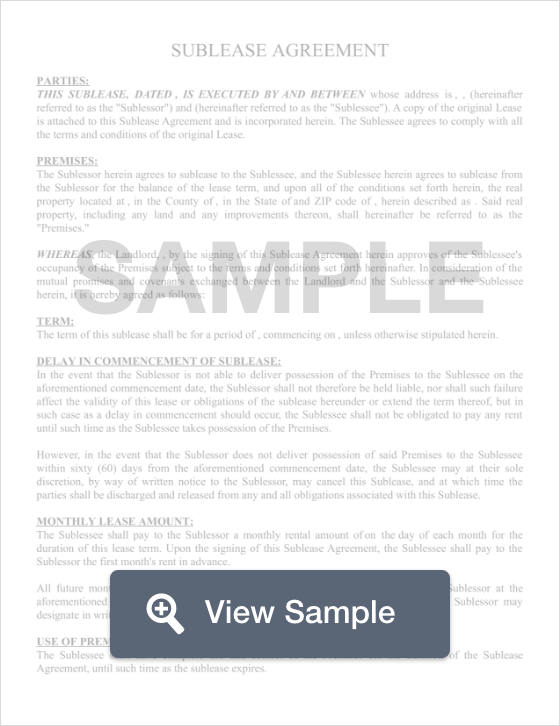Make a California Sublease Agreement
Create a California Sublease Agreement with our customizable template!

What is a California Sublease Agreement?
A California sublease agreement is between the original tenant (sublessor or sublandlord) under a lease agreement for a rental unit and a new individual (sublessee or subtenant) who does not have a direct connection with the original lease agreement; the sublease agreement is tied to and incorporates the original (master) lease.
In California, a landlord can prohibit a tenant from entering into a sublease agreement by means of an explicit provision in the original lease, although some local jurisdictions may still allow a sublease agreement. If the original lease does not contain language giving permission for the tenant to enter into a sublease, the original tenant (sublessor) in California should obtain written permission from the landlord to do so, unless applicable local law states otherwise. The original tenant (sublessor) is still bound by all the requirements/obligations under the original (master) lease agreement.
Looking for other California documents?

Business
- California Non-Compete Agreement
- California Non-Disclosure Agreement
- California Promissory Note

Personal
- California Last Will and Testament
- California Living Will
- California Power Of Attorney

Real Estate
- California Bill Of Sale
- California Eviction Notice
- California Lease Agreement
- California Month-to-Month Lease Agreement
- California Quit Claim Deed
- California Rental Application


Sample California Sublease Agreement


Search Documents
Related Documents
Looking for other California documents?

Business
- California Non-Compete Agreement
- California Non-Disclosure Agreement
- California Promissory Note

Personal
- California Last Will and Testament
- California Living Will
- California Power Of Attorney

Real Estate
- California Bill Of Sale
- California Eviction Notice
- California Lease Agreement
- California Month-to-Month Lease Agreement
- California Quit Claim Deed
- California Rental Application
California Sublease Laws
According to California Tenant Laws, subletting is allowed if it grants you permission in your lease. If the lease makes no mention of subletting, California Law tends to lean in favor of allowing the tenant to sublet the rental although this provisioned isn’t specifically mentioned (CIV § 1995.210). Here is a helpful guide to subletting in California.
A Sample California Sublease Agreement with Examples of Each Step
A California sublease agreement should include the following sections:
- Name of Sublessor (Sublandlord)/Name of Sublessee (Subtenant)/Name of Original Landlord: Both parties to the sublease agreement should be identified by name in the document, as well as any co-sublessors or co-sublessees. In addition, the sublease agreement in California should include the name of the landlord, as well as contact information for the landlord or manager of the property.
- Names of All Other Adult Occupants: The sublease agreement should include the names of all adult persons who will be residing in the unit.
- Description/Site of Rental Unit: This section should include the complete address and description of the rental unit as it appears in the original (master) lease, as well as a list of items in the unit that are covered by the sublease agreement.
- Sublease Agreement Term: This section defines the length of the sublease agreement; the precise start date and end date must be noted.
- Amount of Rent/How Paid: This section includes the amount of rent to be charged, whether it will paid by the week or by the month, the day the rent is due, how the rent will be delivered to the sublessor (e.g., by a mailed check), if there will be a fee for a late payment or insufficient funds, and the amounts of those fees.
- Utilities/Maintenance and Repair: This section delineates the specific utilities and maintenance/repair items that are the responsibility of the sublessor and those that are the obligations of the sublessee.
- Damages/Liability: This section declares the sub lessee's liability for damages to the sublessor, who is still responsible for any damages that affect the landlord under the original (master) lease.
- Security Deposit/Pet Deposit (if any): This section states the amount of the security deposit under the sublease agreement and that it is given to the sublessor. An additional pet deposit may be charged, as can a deposit for any use of the rental unit that poses a risk to the property. In California, the security deposit for an unfurnished unit is limited to two months' rent; the maximum security deposit for a furnished unit is three months' rent. The security deposit, less any lawful deductions, must be refunded within twenty-one days after the sublease agreement has terminated.
- Disputes: This section states the method(s), short of legal action, by which the sublessor and sublessee will resolve any disputes that arise.
- Events of Default and Remedies: This section defines the actions on the part of the sublessee that will constitute a default or breach of the sublease agreement and the options available to the sublessor in those situations, including legal action.
- Attorney's Fees: This section states that if there is a breach of the sublease agreement or legal action taken by either party, the party who secures a judgment can recover attorney's fees and court costs.
- Disclosures: Applicable state law may require that certain disclosures be made to the sublessee in the sublease agreement, in addition to the federal requirement to disclose the possible danger of lead-based paint, if the unit was constructed prior to 1978. In California, several such disclosures are required, including notices regarding toxic mold, pest control services, asbestos, carcinogenic material, methamphetamine contamination, a demolition permit, a former military base (explosives) location, death in the unit, registered sexual offender database, and a condominium conversion project.
- Master Lease/Termination of Master Lease: This section states that the original (master) lease is incorporated in its entirety in the sublease agreement; all of the provisions and requirements/obligations in the master lease are deemed part of the sublease agreement. The master lease should be attached. This section also states that the sublease agreement will terminate simultaneously if the master lease is terminated.
- Rules and Regulations: This section states the activities that are prohibited and/or regulated, including illegal activities, smoking, and pets.
- Consent of Landlord: This section states the manner in which the landlord is giving consent to the sublease agreement, should the original (master) lease not include consent.
- Governing Law: This section states that the sublease agreement is governed by California state law, including all the provisions/requirements in the applicable state code sections.
- Entire Agreement: This section states that the sublease agreement represents the complete agreement between the sublessor and sublessee; the sublease agreement may not be altered except by mutual agreement of the parties in writing.
- Dated Signatures: This section includes the dated signatures of the sublessor (and any co-sublessors), sublessee (and any co-sublessees), and the landlord, who hereby gives written consent to the sublease agreement.
Sublease Resources for Tenants in California
- Tenants Together
- California Department of Fair Employment and Housing
- Santa Monicans for Renters' Rights

Create a California Sublease Agreement in minutes with our professional document builder.













